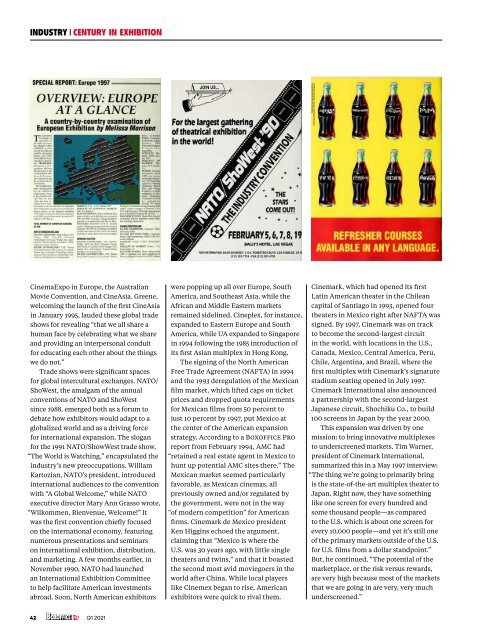Boxoffice Pro Q1 2021
Boxoffice Pro is the official publication of the National Association of Theatre Owners.
Boxoffice Pro is the official publication of the National Association of Theatre Owners.
Create successful ePaper yourself
Turn your PDF publications into a flip-book with our unique Google optimized e-Paper software.
INDUSTRY CENTURY IN EXHIBITION<br />
CinemaExpo in Europe, the Australian<br />
Movie Convention, and CineAsia. Greene,<br />
welcoming the launch of the first CineAsia<br />
in January 1995, lauded these global trade<br />
shows for revealing “that we all share a<br />
human face by celebrating what we share<br />
and providing an interpersonal conduit<br />
for educating each other about the things<br />
we do not.”<br />
Trade shows were significant spaces<br />
for global intercultural exchanges. NATO/<br />
ShoWest, the amalgam of the annual<br />
conventions of NATO and ShoWest<br />
since 1988, emerged both as a forum to<br />
debate how exhibitors would adapt to a<br />
globalized world and as a driving force<br />
for international expansion. The slogan<br />
for the 1991 NATO/ShowWest trade show,<br />
“The World is Watching,” encapsulated the<br />
industry’s new preoccupations. William<br />
Kartozian, NATO’s president, introduced<br />
international audiences to the convention<br />
with “A Global Welcome,” while NATO<br />
executive director Mary Ann Grasso wrote,<br />
“Wilkommen, Bienvenue, Welcome!” It<br />
was the first convention chiefly focused<br />
on the international economy, featuring<br />
numerous presentations and seminars<br />
on international exhibition, distribution,<br />
and marketing. A few months earlier, in<br />
November 1990, NATO had launched<br />
an International Exhibition Committee<br />
to help facilitate American investments<br />
abroad. Soon, North American exhibitors<br />
were popping up all over Europe, South<br />
America, and Southeast Asia, while the<br />
African and Middle Eastern markets<br />
remained sidelined. Cineplex, for instance,<br />
expanded to Eastern Europe and South<br />
America, while UA expanded to Singapore<br />
in 1994 following the 1985 introduction of<br />
its first Asian multiplex in Hong Kong.<br />
The signing of the North American<br />
Free Trade Agreement (NAFTA) in 1994<br />
and the 1993 deregulation of the Mexican<br />
film market, which lifted caps on ticket<br />
prices and dropped quota requirements<br />
for Mexican films from 50 percent to<br />
just 10 percent by 1997, put Mexico at<br />
the center of the American expansion<br />
strategy. According to a <strong>Boxoffice</strong> <strong>Pro</strong><br />
report from February 1994, AMC had<br />
“retained a real estate agent in Mexico to<br />
hunt up potential AMC sites there.” The<br />
Mexican market seemed particularly<br />
favorable, as Mexican cinemas, all<br />
previously owned and/or regulated by<br />
the government, were not in the way<br />
“of modern competition” for American<br />
firms. Cinemark de Mexico president<br />
Ken Higgins echoed the argument,<br />
claiming that “Mexico is where the<br />
U.S. was 30 years ago, with little single<br />
theaters and twins,” and that it boasted<br />
the second most avid moviegoers in the<br />
world after China. While local players<br />
like Cinemex began to rise, American<br />
exhibitors were quick to rival them.<br />
Cinemark, which had opened its first<br />
Latin American theater in the Chilean<br />
capital of Santiago in 1993, opened four<br />
theaters in Mexico right after NAFTA was<br />
signed. By 1997, Cinemark was on track<br />
to become the second-largest circuit<br />
in the world, with locations in the U.S.,<br />
Canada, Mexico, Central America, Peru,<br />
Chile, Argentina, and Brazil, where the<br />
first multiplex with Cinemark’s signature<br />
stadium seating opened in July 1997.<br />
Cinemark International also announced<br />
a partnership with the second-largest<br />
Japanese circuit, Shochiku Co., to build<br />
100 screens in Japan by the year 2000.<br />
This expansion was driven by one<br />
mission: to bring innovative multiplexes<br />
to underscreened markets. Tim Warner,<br />
president of Cinemark International,<br />
summarized this in a May 1997 interview:<br />
“The thing we’re going to primarily bring<br />
is the state-of-the-art multiplex theater to<br />
Japan. Right now, they have something<br />
like one screen for every hundred and<br />
some thousand people—as compared<br />
to the U.S. which is about one screen for<br />
every 10,000 people—and yet it’s still one<br />
of the primary markets outside of the U.S.<br />
for U.S. films from a dollar standpoint.”<br />
But, he continued, “The potential of the<br />
marketplace, or the risk versus rewards,<br />
are very high because most of the markets<br />
that we are going in are very, very much<br />
underscreened.”<br />
42 <strong>Q1</strong> <strong>2021</strong>

















